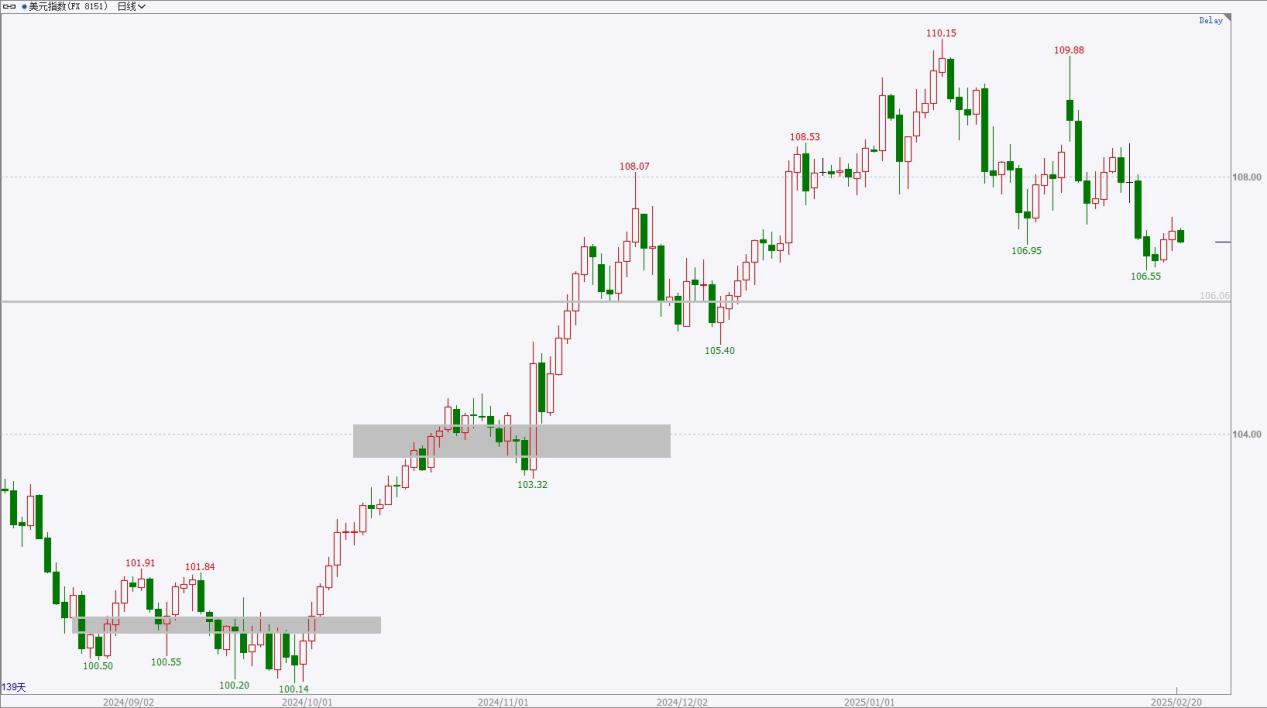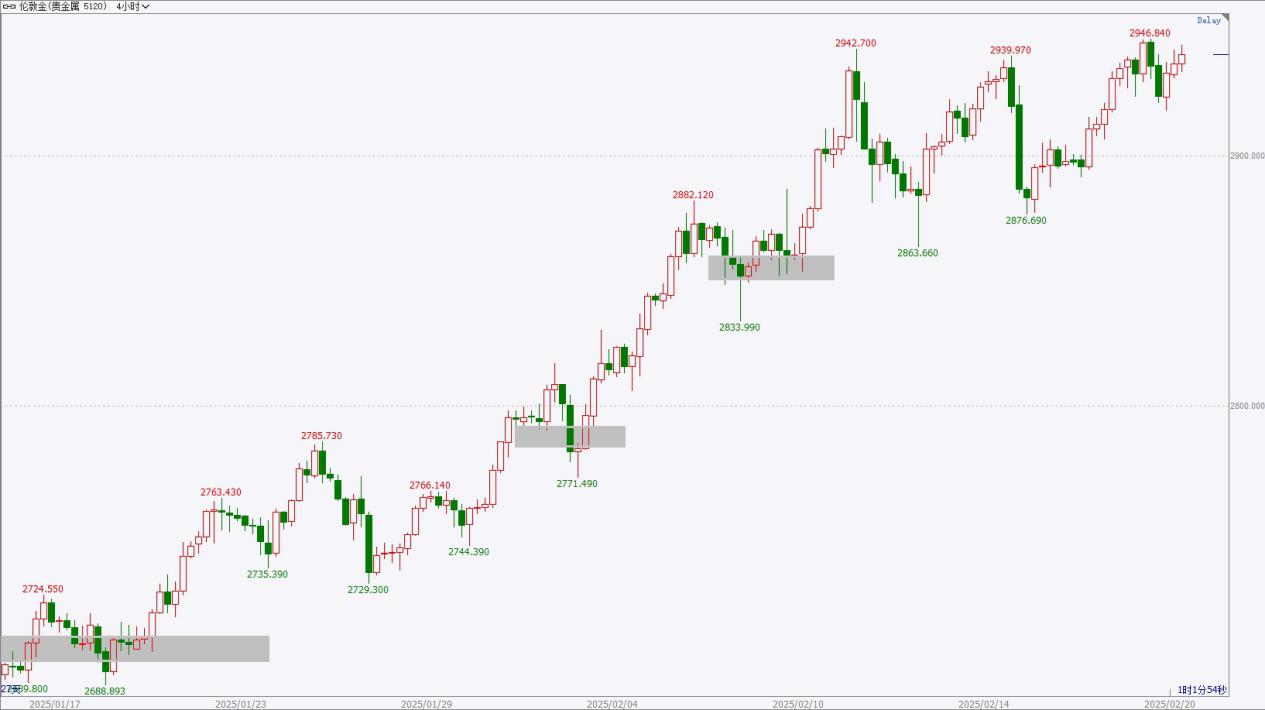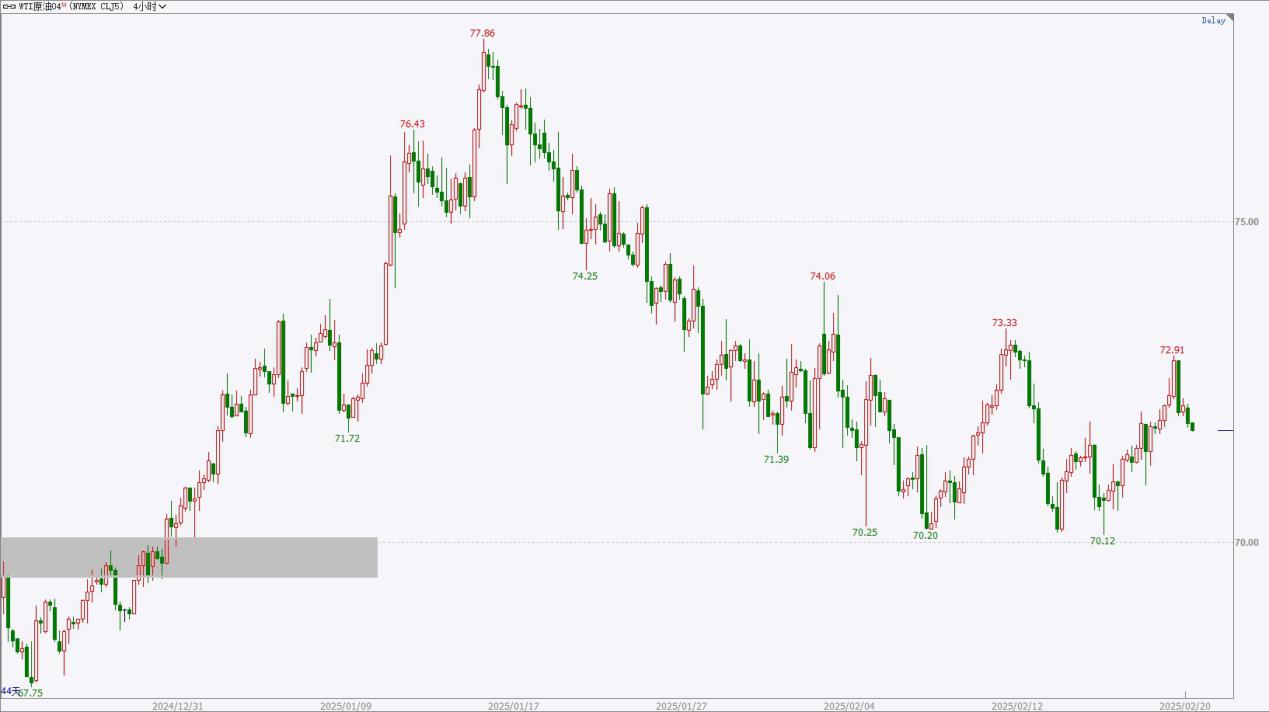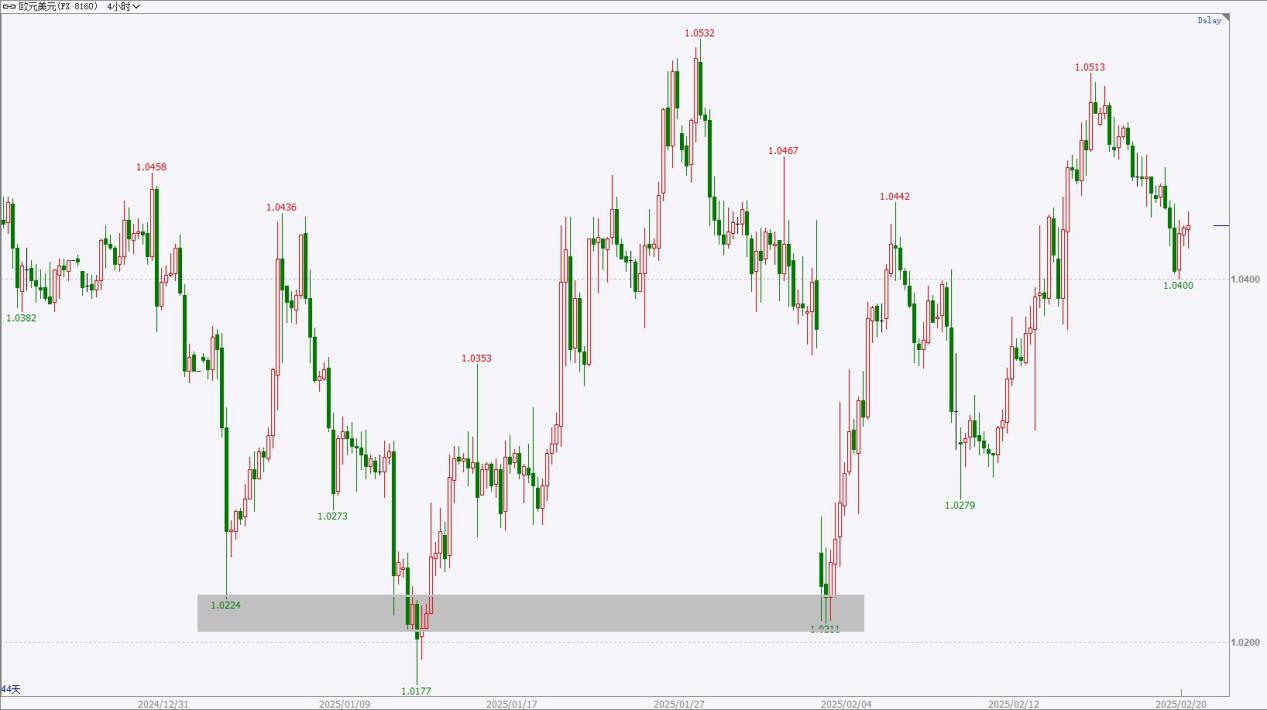|
Time
|
Data and Events
|
Importance
|
|
05:30
|
U.S. API Weekly Crude Oil Stock as of February 14
|
★★★
|
|
06:00
|
Speech by Federal Reserve Vice Chair Jefferson on household balance sheets
|
★★★
|
|
08:30
|
Australia January Seasonally Adjusted Unemployment Rate
|
★★★
|
|
15:00
|
Germany January PPI Monthly Rate
|
★★★
|
|
Switzerland January Trade Balance
|
★★★
|
|
19:00
|
U.K. February CBI Industrial Order Balance
|
★★★
|
|
21:30
|
U.S. Initial Jobless Claims for the week ending February 15
|
★★★★
|
|
U.S. February Philadelphia Fed Manufacturing Index
|
★★★
|
|
22:35
|
Speech by 2025 FOMC voter Goolsbee
|
★★★
|
|
23:00
|
Eurozone February Consumer Confidence Index Preliminary
|
★★★
|
|
U.S. January Conference Board Leading Index Monthly Rate
|
★★★
|
|
Next Day
01:00
|
U.S. EIA Weekly Crude Oil Inventory as of February 14
|
★★★★
|
|
U.S. EIA Crude Oil Inventory at Cushing, Oklahoma as of February 14
|
★★★
|
|
U.S. EIA Strategic Petroleum Reserve Inventory as of February 14
|
★★★
|
|
Next Day
03:30
|
NYMEX New York Crude Oil March Futures Roll Over, Completing Last Trading Day
|
★★★
|
|
Variety
|
Opinion
|
Support Range
|
Resistance Range
|
|
U.S. Dollar Index
|
Weakly Volatile
|
105.5-106
|
108.5-109
|
|
Gold
|
Strongly Volatile
|
2850-2870
|
2980-3000
|
|
Crude Oil
|
Short-term Volatile
|
69-70
|
79-80
|
|
Euro
|
Strongly Volatile
|
1.0180-1.0200
|
1.0500-1.0550
|
*Pre-market opinions are timely and limited, belong to forecasts, and are for reference and learning only. They do not constitute investment advice, and the risks of operations are borne by the individuals themselves. Investment involves risks, and trading requires caution.
Fundamental Analysis:
At the end of January, the Federal Reserve meeting maintained interest rates unchanged. The labor market remains strong, economic activities have been steadily expanding, and inflation levels are still slightly high. Expectations for loosening monetary policy have cooled somewhat, and there will be attention on new government policies. In January, non-farm employment decreased to 143,000, below expectations, while the unemployment rate slightly fell to 4.0%, indicating strong labor market performance. The January unadjusted CPI annual rate recorded at 3.0%, slightly above previous values and expectations. The December core PCE price index remained unchanged from the previous value; January ISM manufacturing PMI slightly increased.
Technical Analysis:

The U.S. Dollar Index showed slight intraday fluctuations, with a rise during nighttime trading followed by a decline. The short cycle appears weak, with selling pressure above. Attention should be paid to the upper pressure structure; if signs of resistance appear in the short cycle, opportunities for short positions should be considered in a timely manner. Overall, the large-scale trend appears strong but has entered a short-term adjustment phase. The upper resistance area is around 108.5-109, while the lower support area is around 105.5-106.
Opinion: Weakly volatile, short cycle rebounding, and short-term opportunities for short positions can be attempted.
*Pre-market opinions are timely and limited, belong to forecasts, and are for reference and learning only. They do not constitute investment advice, and the risks of operations are borne by the individuals themselves. Investment involves risks, and trading requires caution.
Fundamental Analysis:
Geopolitical conflicts in the Middle East continue to worsen, and the situation in Eastern Europe is unstable and uncertain. At the end of January, the ECB decided to cut interest rates by 25 basis points for the fourth consecutive time, with inflation basically in line with expectations, while the economy remains under pressure due to weak performance. In the same period, the Federal Reserve decided to keep interest rates unchanged, with good economic activity but inflation still high, leading to a slight easing of rate cut expectations. The U.S. non-farm payroll data for January was average, with the number of new jobs decreasing, falling short of expectations, while the unemployment rate slightly decreased, performing slightly better than expected; the year-on-year CPI for January showed a slight increase, exceeding expectations.
Technical Analysis:

Gold prices have recently shown strong performance, with signs of a continued upward trend in the short cycle, and no weakening signals have appeared. The short-term strategy is to maintain a low-buy approach, taking profits on highs and paying attention to whether prices can reach new highs. From a long-term perspective, the upward structure is intact, with daily oscillations moving higher and prices frequently setting new highs. Potential resistance levels above may be near 2980-3000, while support levels below may be around 2850-2870.
Viewpoint: Oscillation tends to be strong, primarily maintaining a short-term buying strategy while taking profits on highs.
*Pre-market opinions are timely and limited, belong to forecasts, and are for reference and learning only. They do not constitute investment advice, and the risks of operations are borne by the individuals themselves. Investment involves risks, and trading requires caution.
Fundamental Analysis:
In the February EIA monthly report, the global crude oil demand growth forecast for this year and next was maintained, with slight adjustments to the 2025 oil price; the OPEC monthly report maintained global oil demand growth forecasts for this year and next; the IEA report slightly raised the global oil demand growth forecast for 2025. At the OPEC+ meeting in early February, they adhered to the previous oil production agreement, and the committee agreed to gradually increase oil production starting April 1, consistent with previous plans. EIA crude oil inventories have increased significantly, with recent data showing volatility. Attention should be paid to the EIA crude oil inventory report early Friday morning.
Technical Analysis:

U.S. crude oil night trading experienced a slight rise before falling back, with a short-term oscillation showing potential selling pressure above. Prices may retest the support area, and in the short term, watch for signs of stabilization, at which point short buying opportunities may be considered. Overall, crude oil prices are oscillating but tend toward strength, with large-scale stability signs, while a short-term pullback is expected. Resistance areas above are around 79-80, while support areas below are around 69-70.
Viewpoint: Short-term oscillation, with support areas not breached, watch for stabilization signals to consider buying at lower levels.
*Pre-market opinions are timely and limited, belong to forecasts, and are for reference and learning only. They do not constitute investment advice, and the risks of operations are borne by the individuals themselves. Investment involves risks, and trading requires caution.
Fundamental Analysis:
At the end of January, the ECB decided to cut interest rates by 25 basis points for the fourth consecutive time, with inflation generally meeting expectations and anticipated to return to medium-term goals this year, although the economy still faces challenges and may continue to be weak in the short term, while income and policy effects support demand recovery. Meanwhile, the Federal Reserve maintained its interest rates, with overall economic performance being robust, and easing expectations slightly alleviated. The U.S. non-farm payrolls for January performed moderately, with a decrease in new job numbers, while the unemployment rate decreased slightly, better than expected; the U.S. CPI year-on-year slightly warmed up in January. Focus will be on the Eurozone manufacturing PMI value on Friday.
Technical Analysis:

The euro price continued to decline slightly yesterday, with short-term oscillations retreating, but there is also a support structure below. Attention should be paid to signals indicating a stop and stabilization, at which point low-buy opportunities may be tried, and the upper pressure level should be monitored for a significant break. Overall, the price is at a relatively low level, with daily oscillation structures, and no major stabilization signals have yet appeared. The upper small-level resistance area is around 1.0500-1.0550, while the lower support area is around 1.0180-1.0200.
Viewpoint: Oscillation tends to be strong, focus on buying opportunities at lower levels during retracements, and watch whether the pressure structure can be broken.
*Pre-market opinions are timely and limited, belong to forecasts, and are for reference and learning only. They do not constitute investment advice, and the risks of operations are borne by the individuals themselves. Investment involves risks, and trading requires caution.


Daily Reviews
Our award-winning team of analysts provides keen and insightful technical and fundamental analysis to understand daily market news and investment trading opportunities
HTFX Daily Forex Commentary 0220
Time
Data and Events
Importance
05:30
U.S. API Weekly Crude Oil Stock as of February 14
★★★
06:00
Speech by Federal Reserve Vice Chair Jefferson on household balance sheets
★★★
08:30
Australia January Seasonally Adjusted Unemployment Rate
★★★
15:00
Germany January PPI Monthly Rate
★★★
Switzerland January Trade Balance
★★★
19:00
U.K. February CBI Industrial Order Balance
★★★
21:30
U.S. Initial Jobless Claims for the week ending February 15
★★★★
U.S. February Philadelphia Fed Manufacturing Index
★★★
22:35
Speech by 2025 FOMC voter Goolsbee
★★★
23:00
Eurozone February Consumer Confidence Index Preliminary
★★★
U.S. January Conference Board Leading Index Monthly Rate
★★★
Next Day
01:00
U.S. EIA Weekly Crude Oil Inventory as of February 14
★★★★
U.S. EIA Crude Oil Inventory at Cushing, Oklahoma as of February 14
★★★
U.S. EIA Strategic Petroleum Reserve Inventory as of February 14
★★★
Next Day
03:30
NYMEX New York Crude Oil March Futures Roll Over, Completing Last Trading Day
★★★
Variety
Opinion
Support Range
Resistance Range
U.S. Dollar Index
Weakly Volatile
105.5-106
108.5-109
Gold
Strongly Volatile
2850-2870
2980-3000
Crude Oil
Short-term Volatile
69-70
79-80
Euro
Strongly Volatile
1.0180-1.0200
1.0500-1.0550
*Pre-market opinions are timely and limited, belong to forecasts, and are for reference and learning only. They do not constitute investment advice, and the risks of operations are borne by the individuals themselves. Investment involves risks, and trading requires caution.
Fundamental Analysis:
At the end of January, the Federal Reserve meeting maintained interest rates unchanged. The labor market remains strong, economic activities have been steadily expanding, and inflation levels are still slightly high. Expectations for loosening monetary policy have cooled somewhat, and there will be attention on new government policies. In January, non-farm employment decreased to 143,000, below expectations, while the unemployment rate slightly fell to 4.0%, indicating strong labor market performance. The January unadjusted CPI annual rate recorded at 3.0%, slightly above previous values and expectations. The December core PCE price index remained unchanged from the previous value; January ISM manufacturing PMI slightly increased.
Technical Analysis:
The U.S. Dollar Index showed slight intraday fluctuations, with a rise during nighttime trading followed by a decline. The short cycle appears weak, with selling pressure above. Attention should be paid to the upper pressure structure; if signs of resistance appear in the short cycle, opportunities for short positions should be considered in a timely manner. Overall, the large-scale trend appears strong but has entered a short-term adjustment phase. The upper resistance area is around 108.5-109, while the lower support area is around 105.5-106.
Opinion: Weakly volatile, short cycle rebounding, and short-term opportunities for short positions can be attempted.
*Pre-market opinions are timely and limited, belong to forecasts, and are for reference and learning only. They do not constitute investment advice, and the risks of operations are borne by the individuals themselves. Investment involves risks, and trading requires caution.
Fundamental Analysis:
Geopolitical conflicts in the Middle East continue to worsen, and the situation in Eastern Europe is unstable and uncertain. At the end of January, the ECB decided to cut interest rates by 25 basis points for the fourth consecutive time, with inflation basically in line with expectations, while the economy remains under pressure due to weak performance. In the same period, the Federal Reserve decided to keep interest rates unchanged, with good economic activity but inflation still high, leading to a slight easing of rate cut expectations. The U.S. non-farm payroll data for January was average, with the number of new jobs decreasing, falling short of expectations, while the unemployment rate slightly decreased, performing slightly better than expected; the year-on-year CPI for January showed a slight increase, exceeding expectations.
Technical Analysis:
Gold prices have recently shown strong performance, with signs of a continued upward trend in the short cycle, and no weakening signals have appeared. The short-term strategy is to maintain a low-buy approach, taking profits on highs and paying attention to whether prices can reach new highs. From a long-term perspective, the upward structure is intact, with daily oscillations moving higher and prices frequently setting new highs. Potential resistance levels above may be near 2980-3000, while support levels below may be around 2850-2870.
Viewpoint: Oscillation tends to be strong, primarily maintaining a short-term buying strategy while taking profits on highs.
*Pre-market opinions are timely and limited, belong to forecasts, and are for reference and learning only. They do not constitute investment advice, and the risks of operations are borne by the individuals themselves. Investment involves risks, and trading requires caution.
Fundamental Analysis:
In the February EIA monthly report, the global crude oil demand growth forecast for this year and next was maintained, with slight adjustments to the 2025 oil price; the OPEC monthly report maintained global oil demand growth forecasts for this year and next; the IEA report slightly raised the global oil demand growth forecast for 2025. At the OPEC+ meeting in early February, they adhered to the previous oil production agreement, and the committee agreed to gradually increase oil production starting April 1, consistent with previous plans. EIA crude oil inventories have increased significantly, with recent data showing volatility. Attention should be paid to the EIA crude oil inventory report early Friday morning.
Technical Analysis:
U.S. crude oil night trading experienced a slight rise before falling back, with a short-term oscillation showing potential selling pressure above. Prices may retest the support area, and in the short term, watch for signs of stabilization, at which point short buying opportunities may be considered. Overall, crude oil prices are oscillating but tend toward strength, with large-scale stability signs, while a short-term pullback is expected. Resistance areas above are around 79-80, while support areas below are around 69-70.
Viewpoint: Short-term oscillation, with support areas not breached, watch for stabilization signals to consider buying at lower levels.
*Pre-market opinions are timely and limited, belong to forecasts, and are for reference and learning only. They do not constitute investment advice, and the risks of operations are borne by the individuals themselves. Investment involves risks, and trading requires caution.
Fundamental Analysis:
At the end of January, the ECB decided to cut interest rates by 25 basis points for the fourth consecutive time, with inflation generally meeting expectations and anticipated to return to medium-term goals this year, although the economy still faces challenges and may continue to be weak in the short term, while income and policy effects support demand recovery. Meanwhile, the Federal Reserve maintained its interest rates, with overall economic performance being robust, and easing expectations slightly alleviated. The U.S. non-farm payrolls for January performed moderately, with a decrease in new job numbers, while the unemployment rate decreased slightly, better than expected; the U.S. CPI year-on-year slightly warmed up in January. Focus will be on the Eurozone manufacturing PMI value on Friday.
Technical Analysis:
The euro price continued to decline slightly yesterday, with short-term oscillations retreating, but there is also a support structure below. Attention should be paid to signals indicating a stop and stabilization, at which point low-buy opportunities may be tried, and the upper pressure level should be monitored for a significant break. Overall, the price is at a relatively low level, with daily oscillation structures, and no major stabilization signals have yet appeared. The upper small-level resistance area is around 1.0500-1.0550, while the lower support area is around 1.0180-1.0200.
Viewpoint: Oscillation tends to be strong, focus on buying opportunities at lower levels during retracements, and watch whether the pressure structure can be broken.
*Pre-market opinions are timely and limited, belong to forecasts, and are for reference and learning only. They do not constitute investment advice, and the risks of operations are borne by the individuals themselves. Investment involves risks, and trading requires caution.
Latest Reviews
HTFX Daily Forex Commentary 0819
HTFX Daily Forex Commentary 0815
HTFX Daily Forex Commentary 0812
HTFX Daily Forex Commentary 0811
Choose a Trusted Broker for Trading
Over 300 employees worldwide, more than 1,000 products, top-tier liquidity